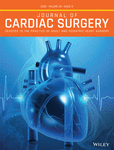Strategic application of modular risk components to safely increase lung transplantation volume
Abstract
Objectives
Considerable growth of individual lung transplant programs remains challenging. We hypothesized that the systematic implementation of modular risk components to a lung transplantation program would allow for expeditious growth without increasing mortality.
Methods
All consecutive patients placed on the lung transplantation waitlist were reviewed. Patients were stratified by an 18-month period surrounding the systematic implementation of the modular risk components Era 1 (1/2014-6/2015) and Era 2 (7/2015-12/2016). Modular risk components were separately evaluated for donors, recipients, and perioperative features.
Results
One hundred and thirty-two waitlist patients (Era 1: 48 and Era 2: 84) and 100 transplants (Era 1: 32 and Era 2: 68) were identified. There was a trend toward decreased waitlist mortality (P = .07). In Era 2, the use of ex vivo lung perfusion (P = .05) and donor-recipient over-sizing (P = .005) significantly increased. Moreover, transplantation with a lung allocation score greater than 70 (P = .05), extracorporeal support (P = .06), and desensitization (P = .008) were more common. Transplant rate significantly improved from Era 1 to Era 2 (325 vs 535 transplants per 100 patient years, P = .02). While primary graft dysfunction (PGD) grade 3 at 72 hours (P = .05) was significantly higher in Era 2, 1-year freedom from rejection was similar (86% vs 90%, P = .69) and survival (81% vs 95%, P = .02) was significantly greater in Era 2.
Conclusions
The systematic implementation of a modular risk components to a lung transplantation program can result in a significant increase in center volume. However, measures to mitigate an expected increase in the incidence of PGD must be undertaken to maintain excellent short and midterm outcomes.




